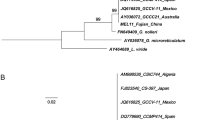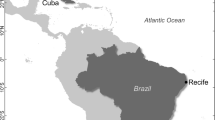Abstract
Blooms of toxic dinoflagellates of the genus Ostreopsis, which is known as a producer of palytoxin (PTX) analogs, may pose a threat to human health in tropical, subtropical, and temperate regions around the world. In the present study, we established a suitable culture method for Ostreopsis spp. isolated from Japanese coastal waters and characterized their growth potential using the method to discuss their bloom dynamics. Each clonal strain of Ostreopsis cf. ovata, Ostreopsis sp. 1, Ostreopsis sp. 5, and Ostreopsis sp. 6 was incubated in 25 × 150 mm test tubes with a flat bottom containing various kinds of medium. Since Ostreopsis spp. strains grew well in IMK and/or f/2 media, we selected these media for cultivation of all the Ostreopsis spp. isolates. Growth rates of O. cf. ovata (0.834 divisions/day), Ostreopsis sp. 1 (0.619 divisions/day), and Ostreopsis sp. 6 (1.04 divisions/day) that produce PTX analogs significantly differed (p < 0.05) respectively and are clearly higher than those of other reported epiphytic dinoflagellate Gambierdiscus toxicus, Prorocentrum lima, and Coolia monotis cultures, which suggest that these species have ecological advantages to predominate through the algal succession in Japanese coastal waters, resulting in a potential risk to human health in this region.


Similar content being viewed by others
References
Moore RE, Scheuer PJ (1971) Palytoxin: a new marine toxin from a coelenterate. Science 172:495–498
Usami M, Satake M, Ishida S, Inoue A, Kan Y, Yasumoto T (1995) Palytoxin analogs from the dinoflagellate Ostreopsis siamensis. J Am Chem Soc 177:5389–5390
Taniyama S, Mahmud Y, Terada M, Takatani T, Arakawa O, Noguchi T (2002) Occurrence of a food poisoning incident by palytoxin from a serranid Epinephelus sp. in Japan. J Nat Toxin 11:277–282
Taniyama S, Arakawa O, Takatani T, Noguchi T (2003) Food poisoning similar to Scarus ovifrons poisoning. New Food Ind 45:55–61
Taniyama S, Arakawa O, Terada M, Nishio S, Takatani T, Mahmud Y, Noguchi T (2003) Ostreopsis sp., a possible origin of palytoxin (PTX) in parrotfish Scarus ovifrons. Toxicon 42:29–33
Yasumoto T, Yasumura D, Ohizumi Y, Takahashi M, Alcala AC, Alcala LC (1986) Palytoxin in two species of xanthid crab from the Philippines. Agric Biol Chem 50:163–167
Shears NT, Ross PM (2009) Blooms of benthic dinoflagellates of the genus Ostreopsis; an increasing and ecologically important phenomenon on temperate reefs in New Zealand and worldwide. Harmful Algae 8:916–925
Aligizaki K, Katikou P, Nikolaidis G, Panou A (2008) First episode of shellfish contamination by palytoxin-like compounds from Ostreopsis species (Aegean Sea, Greece). Toxicon 51:418–427
Wiles JS, Vick JA, Christensen MK (1974) Toxicological evaluation of palytoxin in several animal species. Toxicon 12:427–433
Deeds JR, Schwartz MD (2010) Human risk associated with palytoxin exposure. Toxicon 56:150–162
Ciminiello P, Dell’Aversano C, Fattorusso E, Forino M, Tartaglione L, Grillo C, Melchiorre N (2008) Putative palytoxin and its new analogue, ovatoxin-a, in Ostreopsis ovata collected along the Ligurian coasts during the 2006 toxic outbreak. J Am Soc Mass Spectrom 19:111–120
Parsons ML, Preskitt LB (2007) A survey of epiphytic dinoflagellates from the coastal waters of the island of Hawai’i. Harmful Algae 6:658–669
Sagara T (2008) Profiles of palytoxin-like compounds from the dinoflagellate Ostreopsis sp. isolated from the areas where poisonous fishes were collected. Nippon Suisan Gakkaishi 74:913–914
Taniyama S (2008) The occurrence of palytoxin-like poisoning and ciguatera in parts of the mainland of Japan. Nippon Suisan Gakkaishi 74:917–918
Totti C, Accoroni S, Cerino F, Cucchiari E, Romagnoli T (2010) Ostreopsis ovata bloom along the Conero Riviera (northern Adriatic Sea): relationships with environmental conditions and substrata. Harmful Algae 9:233–239
Aligizaki K, Katikou P, Milandri A, Diogène J (2011) Occurrence of palytoxin-group toxins in seafood and future strategies to complement the present state of the art. Toxicon 57:390–399
Mangialajo L, Ganzin N, Accoroni S, Asnaghi V, Blanfuné A, Cabrini M, Cattaneo-Vietti R, Chavanon F, Chiantore M, Cohu S, Costa E, Fornasaro D, Grossel H, Marco-Miralles F, Masó M, Reñé A, Rossi AM, Sala MM, Thibaut T, Totti C, Vila M, Lemée R (2011) Trends in Ostreopsis proliferation along the Northern Mediterranean coasts. Toxicon 57:408–420
Ciminiello P, Dell’Aversano C, Fattorusso E, Forino M, Magno GS, Tartaglione L, Grillo C, Melchiorre N (2006) The Genoa 2005 outbreak. Determination of putative palytoxin in Mediterranean Ostreopsis ovata by a new liquid chromatography tandem mass spectrometry method. Anal Chem 78:6153–6159
Fukuyo Y (1981) Taxonomical study on benthic dinoflagellates collected in coral reefs. Bull Jpn Soc Sci Fish 47:967–978
Faust MA, Morton SL, Quod JP (1996) Further SEM study of marine dinoflagellates: the genus Ostreopsis (Dinophyceae). J Phycol 32:1053–1065
Penna A, Fraga S, Battocchi C, Casabianca S, Giacobbe MG, Riobó P, Vernesi C (2010) A phylogeographical study of the toxic benthic dinoflagellate genus Ostreopsis Schmidt. J Biogeogr 37:830–841
Rhodes L (2011) World-wide occurrence of the toxic dinoflagellate genus Ostreopsis Schmidt. Toxicon 57:400–407
Mangialajo L, Bertolotto R, Cattaneo-Vietti R, Chiantore M, Grillo C, Lemee R, Melchiorre N, Moretto P, Povero P, Ruggieri N (2008) The toxic benthic dinoflagellate Ostreopsis ovata: quantification of proliferation along the coastline of Genoa, Italy. Mar Pollut Bull 56:1209–1214
Faust MA, Morton SL (1995) Morphology and ecology of the marine dinoflagellate Ostreopsis labens sp. nov. (Dinophyceae). J Phycol 31:456–463
Nakajima I, Ochima Y, Yasumoto T (1981) Toxicity of benthic dinoflagellates in Okinawa. Bull Jpn Soc Sci Fish 47:1029–1033
Sato S, Nishimura T, Uehara K, Sakanari H, Tawong W, Hariganeya N, Smith K, Rhodes L, Yasumoto T, Taira Y, Sudo S, Yamaguchi H, Adachi M (2011) Phylogeography of Ostreopsis along west Pacific coast, with special reference to a novel clade from Japan. PLoS One 6:e27983
Tosteson TR, Ballantine DL, Tosteson CG, Hensley V, Bardales AT (1989) Associated bacterial flora, growth, and toxicity of cultured benthic dinoflagellates Ostreopsis lenticularis and Gambierdiscus toxicus. Appl Environ Microbiol 55:137–141
Morton ST, Norris DR, Bomber JW (1992) Effect of temperature, salinity and light intensity on the growth and seasonality of toxic dinoflagellates associated with ciguatera. J Exp Mar Biol Ecol 157:79–90
Guerrini F, Pezzolesi L, Feller A, Riccardi M, Ciminiello P, Dell’Aversano C, Tartaglione L, Iacovo ED, Fattorusso E, Forino M, Pistocchi R (2010) Comparative growth and toxin profile of cultured Ostreopsis ovata from the Tyrrhenian and Adriatic seas. Toxicon 55:211–220
Granéli E, Vidyarathna NK, Funari E, Cumaranatunga PRT, Scenati R (2011) Can increases in temperature stimulate blooms of the toxic benthic dinoflagellate Ostreopsis ovata? Harmful Algae 10:165–172
Pistocchi R, Pezzolesi L, Guerrini F, Vanucci S, Dell’Aversano C, Fattorusso E (2011) A review on the effects of environmental conditions on growth and toxin production of Ostreopsis ovata. Toxicon 57:421–428
Pezzolesi L, Guerrini F, Ciminiello P, Dell’Aversano C, Iacovo ED, Fattorusso E, Forino M, Tartaglione L, Pistocchi R (2012) Influence of temperature and salinity on Ostreopsis cf. ovata growth and evaluation of toxin content through HR LC-MS and biological assays. Water Res 46:82–92
Vidyarathna NK, Granéli E (2012) Influence of temperature on growth, toxicity and carbohydrate production of a Japanese Ostreopsis ovata strain, a toxic-bloom-forming dinoflagellate. Aquat Microb Ecol 65:261–270
Nascimento SM, Corrêa EV, Menezes M, Varela D, Paredes J, Morris S (2012) Growth and toxin profile of Ostreopsis cf. ovata (Dinophyta) from Rio de Janeiro, Brazil. Harmful Algae 13:1–9
Provasoli L (1968) Media and prospects for the cultivation of marine algae. In: Watanabe A, Hattori A (eds) Cultures and collections of algae. Jpn Soc Plant Physiol, Hakone, pp 63–75
Bold HC, Wynne MJ (1978) Introduction to the algae: structure and reproduction, 1st edn. Prentice Hall of India, New Delhi, pp 1–216
Guillard RRL, Ryther JH (1962) Studies of marine planktonic diatoms. I. Cyclotella nana Hustedt, and Detonula confervacea (Cleve) Gran. Can J Microbiol 8:229–239
Guillard RRL (1975) Culture of phytoplankton for feeding marine invertebrates. In: Smith WL, Chanley MH (eds) Culture of marine invertebrate animals. Plenum, New York, pp 26–60
Itoh K, Imai I (1987) Raphidophyceae. In: Japan Fisheries Resources Conservation Association (ed) A guide for studies of red tide organisms. Shuwa, Tokyo, pp 122–130
Imai I, Itakura S, Matsuyama S, Yamaguchi M (1996) Selenium requirement for growth of a novel red tide flagellate Chattonella verruculosa (Raphidophyceae) in culture. Fish Sci 62:834–835
Brand LE, Guillard RRL, Murphy LS (1981) A method for the rapid and precise determination of acclimated phytoplankton reproduction rates. J Plankton Res 3:193–201
Guillard RRL (1979) Methods for microflagellates and nannoplankton. In: Stein JR (ed) Handbook of phycological methods: culture methods and growth measurements. Cambridge University Press, Cambridge, pp 289–311
Yamaguchi M, Honjo T (1989) Effects of temperature, salinity and irradiance on the growth of the noxious red tide flagellate Gymnodinium nagasakiense (Dinophyceae). Nippon Suisan Gakkaishi 55:2029–2036
Ashton M, Tosteson T, Tosteson C (2003) The effect of elevated temperature on the toxicity of the laboratory cultured dinoflagellate Ostreopsis lenticularis (Dinophyceae). Rev Biol Trop 51:1–6
Yamaguchi H, Sakamoto S, Yamaguchi M (2008) Nutrition and growth kinetics in nitrogen- and phosphorus-limited cultures of the novel red tide flagellate Chattonella ovata (Raphidophyceae). Harmful Algae 7:26–32
Yamaguchi H, Mizushima K, Sakamoto S, Yamaguchi M (2010) Effects of temperature, salinity and irradiance on growth of the novel red tide flagellate Chattonella ovata (Raphidophyceae). Harmful Algae 9:398–401
Yamaguchi H, Sakou H, Fukami K, Adachi M, Yamaguchi M, Nishijima T (2005) Utilization of organic phosphorus and production of alkaline phosphatase by the marine phytoplankton, Heterocapsa circularisquama, Fibrocapsa japonica and Chaetoceros ceratosporum. Plankton Biol Ecol 52:67–75
Bomber JW, Guillard RRL, Nelson WG (1988) Rôles of temperature, salinity, and light in seasonality, growth, and toxicity of ciguatera-causing Gambierdiscus toxicus Adachi et Fukuyo (Dinophyceae). J Exp Mar Biol Ecol 115:53–65
Lartigue J, Jester ELE, Dickey RW, Villareal TA (2009) Nitrogen source effects on the growth and toxicity of two strains of the ciguatera-causing dinoflagellate Gambierdiscus toxicus. Harmful Algae 8:781–791
Acknowledgments
This study was supported by a grant-in-aid from the Food Safety Commission, Japan (no. 0904).
Author information
Authors and Affiliations
Corresponding author
Rights and permissions
About this article
Cite this article
Yamaguchi, H., Tanimoto, Y., Yoshimatsu, T. et al. Culture method and growth characteristics of marine benthic dinoflagellate Ostreopsis spp. isolated from Japanese coastal waters. Fish Sci 78, 993–1000 (2012). https://doi.org/10.1007/s12562-012-0530-4
Received:
Accepted:
Published:
Issue Date:
DOI: https://doi.org/10.1007/s12562-012-0530-4




